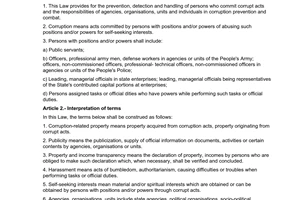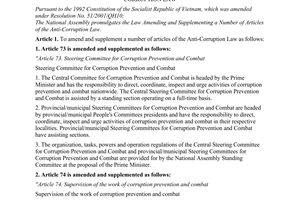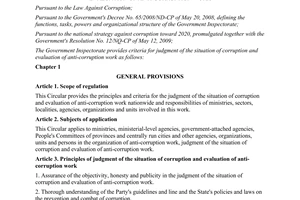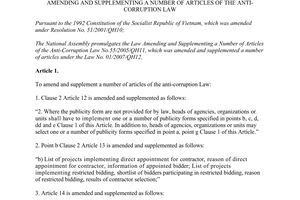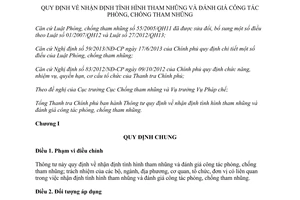Nội dung toàn văn Circular No. 04/2014/TT-TTCP judgment of the situation of corruption and evaluation of anti-corruption work
|
THE GOVERNMENT |
THE SOCIALIST
REPUBLIC OF VIETNAM |
|
No. 04/2014/TT-TTCP |
Hanoi, September 18, 2014 |
CIRCULAR
ON JUDGMENT OF THE SITUATION OF CORRUPTION AND EVALUATION OF ANTI-CORRUPTION WORK
Pursuant to Anti-Corruption Law No. 55/2005/QH11, which was amended and supplemented under Law No. 01/2007/QH12 and Law No. 27/2012/QH13;
Pursuant to the Government’s Decree No. 59/2013/ND-CP of June 17, 2013, detailing a number of articles of the Anti-Corruption Law;
Pursuant to the Government’s Decree No. 83/2012/ND-CP of October 9, 2012, defining the functions, tasks, powers and organizational structure of the Government Inspectorate;
At the proposal of the Director of the Anti-Corruption Bureau and the Director of the Legal Affairs Department;
The Inspector General promulgates the Circular on judgment of the situation of corruption and evaluation of anti-corruption work.
Chapter 1
GENERAL PROVISIONS
Article 1. Scope of regulation
This Circular-provides the judgment of the situation of corruption and evaluation of anticorruption work and responsibilities of ministries, sectors, localities, agencies, organizations and units involved in the judgment of the situation of corruption and evaluation of anti-corruption work.
Article 2. Subjects of application
This Circular applies to ministries, ministerial-level agencies, government-attached agencies, provincial-level People’s Committees and agencies, organizations, units and persons involved in the judgment of the situation of corruption and evaluation of anti-corruption work.
Article 3. Principles of judgment of the situation of corruption and evaluation of anticorruption work
1. Conformity with guidelines and line of the Party, compliance with state policy and law on anti-corruption and other related management domains.
2. Assurance of objectivity, comprehensiveness, truthfulness, publicity and transparency.
3. Promotion of the role and responsibility and involvement of the people, businesses, cadres, civil servants, public employees and related agencies and organizations in the judgment of the situation of corruption and evaluation of anti-corruption work.
4. Publicity of results of and information and data related to the judgment of the situation of corruption and evaluation of anti-corruption work, except those of state secrets as prescribed by law.
5. Assurance of combination of state agencies’ self-judgment and evaluation with perception and experiences of the people, businesses, cadres, civil servants and public employees about the situation of corruption and anti-corruption work.
6. Results of the judgment of the situation of corruption and evaluation of anti-corruption work shall be used as a reference for analysis and suggestion of solutions to raising the effectiveness of anti-corruption but not for classification and ranking of ministries, sectors and localities.
Article 4. Collection of information and data and reporting on results of the judgment of the situation of corruption and evaluation of anti-corruption work
1. The collection of information and data and reporting on results of the judgment of the situation of corruption and evaluation of anti-corruption work must comply with the provisions on communication and reporting in the Government Inspectorate’s Circular No. 03/2013/TT-TTCP of June 10, 2013, prescribing the reporting on inspection, settlement of complaints and denunciations and anti-corruption work, and the Government Inspectorate’s guidance.
2. In addition to complying with Clause 1 of this Article, in their annual judgment of the situation of corruption and evaluation of anti-corruption work, ministries, sectors and localities shall collect information and data through sociological surveys, direct interviews or other forms of online survey on perception and experiences of the people, businesses, cadres, civil servants and public employees.
3. The data collection period is from December 16 of the preceding year to December 15 of the reporting year. Based on reports on the judgment of the situation of corruption and evaluation of anti-corruption work of ministries, sectors and localities, the Government Inspectorate shall review and judge the situation of corruption and evaluate anti-corruption work nationwide. When necessary, the Government Inspectorate shall conduct surveys with appropriate contents and scale and relevant target groups to additionally collect information and data for verification.
Chapter II
JUDGMENT OF THE SITUATION OF CORRUPTION
Article 5. Contents of judgment of the situation of corruption
The situation of corruption shall be judged based on the following specific contents:
a/ Level of prevalence of corrupt acts;
b/ Level of economic damage caused by corruption;
c/ Level of seriousness of corrupt acts.
2. Pursuant to Clause 1 of this Article, ministries, sectors and localities may add or concretize contents of judgment of the situation of corruption to meet the requirements of anti-corruption work within their sectors, industries or localities.
Article 6. Methods of judging the situation of corruption
1. Ministries, sectors and localities shall themselves judge the situation of corruption based on the contents prescribed in Clause 1, Article 5 of this Circular and the overall score of component scores using a 100-point scale, specifically as follows:
a/ Component score 1 may range from maximum 30 points to minimum 0 point based on statistics summarized by sector, industry and locality as prescribed at Point a, Clause 3, Article 7; Point a, Clause 3, Article 8; and Point a, Clause 3, Article 9, of this Circular;
b/ Component score 2 may range from maximum 40 points to minimum 0 point based on results of surveys on perception and experiences of the people, businesses, cadres, civil servants and public employees as prescribed at Point b, Clause 3, Article 7; Point b, Clause 3, Article 8; and Point b, Clause 3, Article 9, of this Circular;
c/ The overall score shall be calculated as follows:
Overall score = (2) x Component score 1 + (1) x Component score 2
For example: If statistics show that component score 1 is 20 points and component score 2 is 30 points, the overall score will be: 2 x 20 + 1 x 30 = 70.
4. Based on the overall scores, ministries, sectors and localities shall themselves judge the situation of corruption based on the contents prescribed in Clause 1, Article 5 of this Circular at the following specific levels:
a/ Level of prevalence of corrupt acts:
- Very common;
- Common;
- Less common;
- Uncommon.
b/ Level of economic damage caused by corruption
- Extremely great;
- Great;
- Moderate;
- Little;
- No damage.
c/ Level of seriousness of corrupt acts:
- Particularly serious;
- Very serious;
- Serious;
- Less serious;
- Unserious.
5. Ministries, sectors and localities shall annually send results of their own judgment of the situation of corruption and relevant information and data to the Government Inspectorate for state management of anti-corruption.
Article 7. Level of prevalence of corrupt acts
1. The level of prevalence of corrupt acts reflects the frequency of occurrence of corrupt acts within sectors, industries or localities or nationwide, which is measured by the number of cases and matters in which corrupt acts are detected and handled by competent state agencies and perceived and experienced by the people, businesses, cadres, civil servants and public employees.
2. The number of corruption cases and matters detected and handled by state agencies is the total number of cases and matters which are confirmed as involving corrupt acts through state management, inspection, examination, audit, investigation, procuracy and trial activities as prescribed by law and summarized by sector, industry and locality and nationwide.
3. The calculation of scores and determination of the level of prevalence of corrupt acts are as follows:
a/ Component score 1 shall be determined based on the number of corruption cases and matters which are confirmed through state management, inspection, examination, audit, investigation, procuracy and trial activities.
- 10 cases and matters or more: 30 (points);
- Between 5 and 9 cases and matters: 20 (points);
- Between 1 and 4 cases and matters: 10 (points);
- No case and matter: 0 (point).
b/ Component score 2 shall be determined based on perception and experiences of the people, businesses, cadres, civil servants and public employees about the level of prevalence of corrupt acts.
- Very common: 40 (points);
- Common: 30 (points);
- Less common: 20 (points);
- Uncommon: 0 (point).
c/ Determination and judgment of the level of prevalence of corrupt acts:
- Overall score of between over 70 (points) and 100 (points) corresponds to the level of “very common”;
- Overall score of between over 40 (points) and 70 (points) corresponds to the level of “common”;
- Overall score of between over 0 (point) and 40 (points) corresponds to the level of “less common”;
- Overall score of 0 (point) corresponds to the level of “uncommon”.
For example: For a province which has 10 cases and matters confirmed as involving corrupt acts and the results of the survey on the perception and experiences of the people, businesses, cadres, civil servants and public employees show a very common level of prevalence of corrupt acts, the component scores and overall score will be as follows: component score 1: 30 (points); component score 2: 40 (points) and overall score: 2 x 30 + 1 x 40 = 100 (points). Therefore, corrupt acts are judged as “very common”.
Article 8. Level of economic damage caused by corruption
1. The level of economic damage caused by corruption means the illicit value caused by corrupt acts which has been confirmed by and recovered or economically handled under the decision of a competent state agency in a corruption case or matter and perceived and experienced by the people, businesses, cadres, civil servants and public employees. An economic damage caused by corruption to objects other than money or valuable papers shall be converted into Vietnamese currency at the market price of similar objects or at the exchange rate announced by the State Bank of Vietnam at the time of judgment for summarization.
2. The illicit value caused by corrupt acts which have been confirmed by and recovered or economically handled under decisions of competent state agencies in corruption cases and matters through inspection, examination, audit, investigation, procuracy, trial, supervision and denunciation settlement activities prescribed by law shall be determined and summarized by sector, industry and locality and nationwide.
3. The calculation of scores and determination of the level of economic damage caused by corruption are as follows:
a/ Component score 1 shall be calculated based on the illicit value caused by corrupt acts which have been confirmed by and recovered or economically handled under decisions of competent state agencies in corruption cases and matters through inspection, examination, audit, investigation, procuracy, trial, supervision and denunciation settlement activities.
- The illicit value accounts for 10% or higher of the total state budget expenditure of the year preceding the period of general judgment by sector, industry or locality: 30 (points);
- The illicit value accounts for between 5% and under 10% of the total state budget expenditure of the year preceding the period of general judgment by sector, industry or locality: 20 (points);
- The illicit value accounts for between 1% and under 5% of the total state budget expenditure of the year preceding the period of general judgment by sector, industry or locality: 10 (points);
- The illicit value accounts for under 1% of the total state budget expenditure of the year preceding the period of general judgment by sector, industry or locality: 5 (points);
- The illicit value accounts for 0% of the total state budget expenditure of the year preceding the period of general judgment by sector, industry or locality is: 0 (point).
When ministries, ministerial-level agencies, government-attached agencies or provincial- level People’s Committees are assigned to exercise the owner right over state capital in enterprises, component score 1 shall be calculated based on the proportion of the illicit value to the total state budget expenditure of the year preceding the period of general judgment by sector, industry or locality and the total asset value of state-owned enterprises at the time of judgment.
b/ Component score 2 shall be determined based on the results of surveys on perception and experiences of the people, businesses, cadres, civil servants and public employees about the level of economic damage caused by corruption.
- Extremely great: 40 (points);
- Great: 30 (points);
- Moderate: 20 (points);
- Little: 10 (points);
- No damage: 0 (point).
c/ Determination and judgment of the level of economic damage caused by corruption:
- Overall score of between over 70 (points) and 100 (points) corresponds to the level of “extremely great”;
- Overall score of between over 40 (points) and 70 (points) corresponds to the level of “great”;
- Overall score of between over 20 (points) and 40 (points) corresponds to the level of “moderate”;
- Overall score of between over 0 (point) and 20 (points) corresponds to the level of “little”;
- Overall score of 0 (point) corresponds to the level of “no damage”.
For example: If the economic damage caused by corruption accounts for 10% of the total state budget expenditure of a sector, industry or locality and the survey on perception and experiences of the people, businesses, cadres, civil servants and public employees shows that the economic damage caused by corruption is extremely great, the component scores and overall score will be as follows: component score 1: 30 (points); component score 2: 40 (points) and overall score: 2 x 30 + 1 x 40 = 100 (points). So the economic damage caused by corruption is judged as “extremely great”.
Article 9. Level of seriousness of corrupt acts
1. The level of seriousness of corrupt acts reflects the level of dangerousness and harm caused by corrupt acts to the society in'general, which is measured through the results of handling corrupt persons by competent state agencies and through the perception and experiences of the people, businesses, cadres, civil servants and public employees.
2. The results of handling corrupt persons shall be determined based on statistics about persons who are disciplined or criminally handled in specific forms applied by competent state agencies in each sector, industry and locality and nationwide through state management, inspection, examination, audit, investigation, procuracy and trial activities.
3. The calculation of scores and determination of the level of seriousness of corrupt acts are as follows:
a/ Component score 1 shall be determined based on the forms of handling corrupt persons by sector, industry and locality through state management, inspection, examination, audit, investigation, procuracy and trial activities.
- Having corrupt persons who are sentenced to penalties applicable to the group of particularly serious crimes: 30 (points);
- Having corrupt persons who are sentenced to penalties applicable to the group of very serious crimes: 20 (points);
- Having corrupt persons who are sentenced to penalties applicable to the group of serious crimes: 10 (points);
- Having corrupt persons who are sentenced to penalties applicable to the group of less serious crimes or who are disciplined: 5 (points);
- Having no person handled for corrupt acts: 0 (point).
b/ Component score 2 shall be determined based on the results of surveys on the perception and experiences of the people, businesses, cadres, civil servants and public employees about the level of seriousness of corrupt acts as follows:
- Particularly serious: 40 (points);
- Very serious: 30 (points);
- Serious: 20 (points);
- Less serious: 10 (points);
- Unserious: 0 (point).
c/ Determination and judgment of the level of seriousness:
- Overall score of between over 70 (points) and 100 (points) corresponds to the level of “particularly serious”;
- Overall score of between over 40 (points) and 70 (points) coưesponds to the level of “very serious”;
- Overall score of between over 20 (points) and 40 (points) coưesponds to the level of “serious”;
- Overall score of between over 0 (point) and 20 (points) corresponds to the level of “less serious”;
- Overall score of 0 (point) corresponds to the level of “unserious”.
For example: If the results of handling corruption in a sector, industry or locality cover disciplining and criminal handling which include persons sentenced to penalties applicable to the group of particularly serious crimes and the survey on the perception and experiences of the people, businesses, cadres, civil servants and public employees shows that corrupt acts are particularly serious, the component scores and overall score will be as follows: component score 1: 30 (points); component score 2: 40 (points) and overall score: 2 x 30 + 1 x 40= 100 (points). So the situation of corruption is judged as “particularly serious”.
Chapter III
EVALUATION OF ANTI-CORRUPTION WORK
Article 10. Contents of evaluation of anti-corruption work
1. Anti-corruption work shall be evaluated based on the following specific contents:
a/ Direction and administration of anti-corruption work;
b/ Elaboration and organization of implementation of the law on anti-corruption;
c/ Implementation of corruption prevention measures;
d/ Detection and handling of corrupt acts, recovery of corruption-related assets.
2. Pursuant to Clause 1 of this Article, ministries, sectors or localities may add contents of evaluation of anti-corruption work to meet their state management requirements.
Article 11. Methods of evaluating anti-corruption work
1. Ministries, sectors or localities shall themselves evaluate anti-corruption work within sectors, industries or localities under their management based on the overall score of between 0 point and 100 points, specifically as follows:
a/ Component score 1 may range from maximum 30 (points) to minimum 0 (point) based on the total points of evaluation contents prescribed in Clause 1, Article 10 of this Circular;
b/ Component score 2 may range from maximum 40 (points) and minimum 0 (point) based on the perception and experiences of the people, businesses, cadres, civil servants and public employees about anti-corruption work;
c/ The overall score shall be calculated as follows:
Overall score = (2) x Component score 1 + (1) x Component score 2
For example: If statistics show that component score 1 is 20 (points) and component score 2 is 30 (points), the overall score will be: 2 x 20 + 1 x 30 = 70.
2. Ministries, sectors and localities shall annually send results of their evaluation of anti-corruption work and relevant information and data to the Government Inspectorate for state management of anti-corruption.
Article 12. Evaluation of the direction and administration of anti-corruption work
1. The direction and administration of anti-corruption work shall be evaluated according to the following criteria:
a/ Elaboration, adoption and implementation of annual plans on examination and inspection of the implementation of the law on anti-corruption;
b/ Implementation of regulations on periodical and irregular reporting on anti-corruption work as prescribed by law;
c/ Elaboration, adoption and implementation of plans to disseminate and raise awareness about anti-corruption;
d/ Evaluation of the effectiveness of anti-corruption work and association of anticorruption results with emulation and commendation work.
2. Evaluation of the direction and administration of anti-corruption work shall be scored as follows:
a/ The maximum score is 6 points and the minimum score is 0 point;
b/ Failure to implement one of the criteria prescribed in Clause 1 of this Article is subject to subtraction of 1.5 (points);
c/ Failure to fully implement or implement on schedule one of the criteria prescribed in Clause 1 of this Article is subject to subtraction of 0.75 (point).
Article 13. Evaluation of the elaboration and organization of implementation of law related to anti-corruption
1. The elaboration and organization of implementation of the law related to anti-corruption work shall be evaluated according to the following criteria:
a/ Elaboration, adoption and implementation of plans to elaborate legal documents in general, including those concerning anti-corruption;
b/ Elaboration, adoption and implementation of plans to review and systemize legal documents in general, including those concerning anti-corruption;
c/ Elaboration, adoption and implementation of plans to thoroughly grasp and examine the implementation of legal documents in general, including those concerning anti-corruption.
2. Evaluation of the elaboration and organization of implementation of law related to anti-corruption shall be scored as follows:
a/ The maximum score is 6 points and the minimum score is 0 point;
b/ Failure to implement one of the criteria prescribed in Clause 1 of this Article is subject to subtraction of 2 (points);
c/ Failure to fully implement or implement on schedule one of the criteria prescribed in Clause 1 of this Article is subject to subtraction of 1 (point).
Article 14. Evaluation of the implementation of corruption prevention measures
1. The implementation of corruption prevention measures shall be evaluated in accordance with the Anti-Corruption Law and the following criteria:
a/ Elaboration, adoption and implementation of plans to implement corruption prevention measures as prescribed by law and guided by the Government Inspectorate;
b/ Application and implementation of corruption prevention measures in administration activities as required by law when practical circumstances emerge;
c/ Adoption of mechanisms to collect information and examine and handle cases of failing to implement, implementing improperly or failing to promptly implement corruption prevention measures.
2. Evaluation of the implementation of corruption prevention measures shall be scored as follows:
a/ The maximum score is 9 points and the minimum score is 0 point;
b/ Failure to implement one of the criteria prescribed in Clause 1 of this Article is subject to subtraction of 3 (points);
c/ Failure to fully implement or implement on schedule one of the criteria prescribed in Clause 1 of this Article is subject to subtraction of 1.5 (points).
Article 15. Evaluation of the detection and handling of corrupt acts and recovery of corruption-related assets
1. The evaluation of the detection and handling of corrupt acts and recovery of corruption- related assets must comply with the Anti-Corruption Law and be based on the following criteria:
a/ Elaboration, adoption and implementation of plans to periodically or frequently examine individuals, agencies, organizations and units under management in performing their tasks and powers;
b/ Elaboration, adoption and implementation of annual inspection plans, covering administrative inspection or irregular inspection for detection and handling of corrupt acts;
c/ Results of settlement of denunciations about corrupt acts and handling of denounced corrupt persons according to competence prescribed by law;
d/ Results of implementation of decisions on recovery of money and assets and decisions on handling of violators detected through state management, examination and inspection activities.
2. Evaluation of the detection and handling of corrupt acts and recovery of corruption- related assets shall be scored as follows:
a/ The maximum score is 9 points and the minimum score is 0 point;
b/ Recovery of less than 25% of money and assets of violation or handling of less than 25% of violating persons or organizations through state management, examination and inspection activities is subject to subtraction of 3 (points);
c/ Failure to adopt and implement examination or inspection plans or failure to conduct examination or inspection; fulfillment of less than 25% of examination or inspection plans; settlement of less than 25% of denunciations about corrupt acts which have been accepted under competence; or recovery of less than 50% of money and assets or handling of less than 50% of violating individuals and organizations is subject to subtraction of 2 (points);
d/ Fulfillment of less than 50% of examination or inspection plans; settlement of less than 50% of denunciations about corrupt acts which have been accepted under competence; or recovery of less than 50% of money and assets or handling of less than 50% of violating individuals and organizations is subject to subtraction of 1 (point);
dd/ Fulfillment of less than 70% of examination or inspection plans; settlement of less than 70% of denunciations about corrupt acts which have been accepted under competence; or recovery of less than 80% of money and assets or handling of less than 80% of violating individuals and organizations is subject to subtraction of 0.5 (point);
e/ Fulfillment of less than 80% of examination or inspection plans; settlement of less than 80% of denunciation about corrupt acts'which have been accepted under competence; delay in implementation of the activities under the criteria prescribed at Points a and b, Clause 1 of this Article is subject to subtraction of 0.25 (point);
Chapter IV
ORGANIZATION OF IMPLEMENTATION
Article 16. Responsibilities of the Government Inspectorate
1. To guide, urge and examine ministries, ministerial-level agencies, government- attached agencies and provincial-level People’s Committees in annually judging the situation of corruption and evaluating anti-corruption work under this Circular.
2. To assume the prime responsibility for, and coordinate with related ministries, sectors, localities and agencies in, mobilizing, managing and using necessary resources for the judgment of the situation of corruption and evaluation of anti-corruption work in accordance with law.
3. To judge the situation of corruption in state management domains of the inspectorate and anti-corruption work of the Government Inspectorate; to review, judge and evaluate the situation of corruption and anti-corruption work nationwide.
Article 17. Responsibilities of ministries, ministerial-level agencies, government- attached agencies and provincial-level People’s Committees
1. Annually, to thoroughly grasp and carry out the judgment of the situation of corruption and evaluation of anti-corruption work within sectors, industries and localities under their management as prescribed in this Circular and guided by the Government Inspectorate.
2. To mobilize in coordination with the Government Inspectorate necessary resources for the judgment of the situation of corruption and evaluation of anti-corruption work in accordance with current law.
3. To coordinate with and provide the Government Inspectorate with necessary information and data related to results of self-judgment of the situation of corruption and evaluation of anti-corruption work within sectors, industries and localities under their management.
Article 18. Coordination with related agencies and organizations in the judgment of the situation of corruption and evaluation of anti-corruption work
The State Audit Office, the Supreme People’s Court, the Supreme People’s Procuracy, the Vietnam Fatherland Front Central Committee and central agencies of socio-political organizations shall, within the ambit of their functions, tasks and powers, coordinate with and direct their attached agencies, units and organizations under their line management in coordinating with the Government Inspectorate, ministries, ministerial-level agencies, government-attached agencies and provincial-level People’s Committees in judging the situation of corruption and evaluating anti-corruption work in accordance with this Circular.
Article 19. Funds for the judgment of the situation of corruption and evaluation of anticorruption work
1. Funds for the judgment of the situation of corruption and evaluation of anti-corruption work shall be allocated from the state budget.
Annually, the Government Inspectorate, ministries, ministerial-level agencies, government-attached agencies and provincial-level People’s Committees shall make state budget estimates for the judgment of the situation of corruption and evaluation of anti-corruption work in accordance with current law.
2. Ministries, ministerial-level agencies, government-attached agencies and provincial- level People’s Committees may mobilize official development assistance or other lawful sources for the judgment of the situation of corruption and evaluation of anti-corruption work.
Article 20. Implementation provisions
1. This Circular replaces Circular No. 11/2011/TT-TTCP of November 9, 2011, and takes effect on January 1, 2015.
2. Any problems arising in the course of implementation should be reported to the Government Inspectorate for guidance, amendment and supplementation as appropriate.-
|
|
INSPECTOR
GENERAL |
